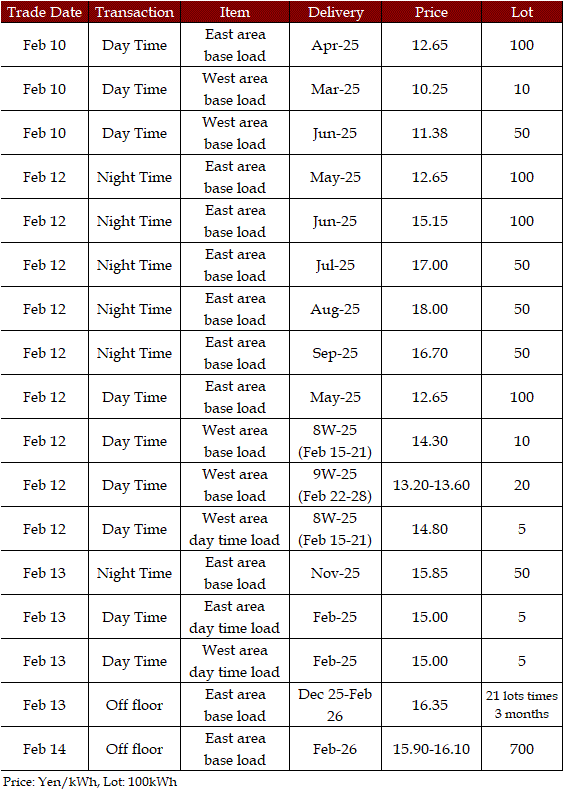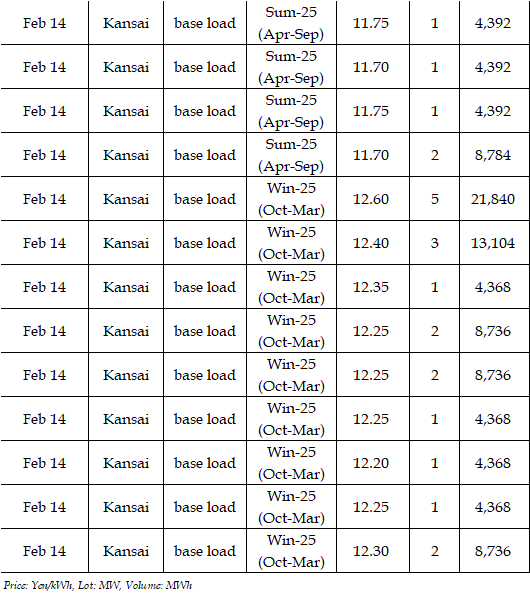|
In the day-ahead market on JEPX (Japan Electric Power Exchange), the 24-hour spot power prices on a weekly average basis for Feb 10-14 delivery remained almost intact from the previous week in East Japan (50Hz), but turned lower in West Japan (60Hz). West Japan had more sunny days than the previous week, and alleviated chilly climate also capped spot prices. Especially in Kyushu, snowfall was observed in Fukuoka and southern Kyushu in the previous week, but the highest temperature often reached double digits from Feb 11 onward. Supply-demand fundamentals loosened up during midday (08:00-16:00 hours), causing a flood of Yen 0.01 throughout the week.
In Tokyo and Kansai, the key areas in East Japan and West Japan, the 24-hour average posted a difference in favor of the West by Yen 0.20 for Feb 10 delivery and Yen 0.02 for Feb 11 delivery. But Tokyo outperformed Kansai by Yen 0.06 for Feb 12 delivery, Yen 1.25 for Feb 13 delivery and Yen 0.59 for Feb 14 delivery. Meanwhile, the East-West spreads were actively traded recently. The March spreads were heard traded at less than Yen 3 in favor of the East.
The fuel market trends in the second week of February were detailed as follows.
DES Northeast Asia spot LNG prices stood in the mid $16 level per mmBtu for prompt March 2025 arrival as of Feb 13, rallying sharply by about $1.50 from the end of the previous week (Feb 7). An upsurge in European natural gas prices pushed up the LNG market in Northeast Asia. The benchmark Dutch TTF (Title Transfer Facility) natural gas prices jumped to reach 58 euros per ton, marking the highest settlement price since April 2023. The price strength in Europe came amid looming cold waves, together with the tariff policy by US. The Ministry of Economy, Trade and Industry (METI) announced on Feb 12 that Japan's LNG inventories for power generation stood at 2.15 mil mt as of Feb 9, down 260,000mt from a week before. The figure was down both from 2.18 mil mt that was the end-February level last year and also the average of past five years.
FOB Newcastle thermal coal prices in Australia stood in the low $104 level per ton for February 2025 loading as of Feb 13. The level was down nearly $3 from the end of the previous week. Falling demand accelerated the decline in coal prices.
In the crude oil market, WTI crude for March 2025 stood in the mid $71 level per barrel as of the morning on Feb 14 while Brent crude for April 2025 was trading in the low $75 level. Compared with the end of the previous week, WTI was up about 50cts while Brent firmed up by slightly less than $1.00. Bullish and bearish factors played a tug of war throughout the week. But crude oil prices found support from bargain hunting, combined with concerns over shrinking crude oil supply from Iran and Russia. Still, the market's upside room was capped by expectations that US and Russia would soon begin ceasefire talks on the Ukraine war. A larger-than-expected buildup in US crude oil inventories also served as a bearish factor.
The actual highest price during the week was at Yen 30.00 in five areas in West Japan excluding Shikoku for Feb 12 delivery. Meanwhile, the actual lowest price during the week was at Yen 0.01 in Shikoku and Kyushu for Feb 11 and Feb 12 delivery, and Kyushu for Feb 13 and Feb 14 delivery.
By area, the weekly average of the 24-hour spot prices was at Yen 14.54 in Hokkaido, up Yen 0.12 from the previous week, Yen 14.57 in Tohoku, up Yen 0.02, Yen 15.17 in Tokyo, up Yen 0.04, Yen 15.30 in Chubu, down Yen 0.49, Yen 14.83 in Hokuriku and Kansai, down Yen 0.64, Yen 14.81 in Chugoku, down Yen 0.66, Yen 10.64 in Shikoku, up Yen 0.44, and Yen 13.10 in Kyushu, down Yen 1.78.
In the JEPX auction, volumes of offers were 1,265.77 mil kWh on a weekly average basis, up 6.6% from the previous week. Meanwhile, bids on a weekly average basis waned by 3.3% to 1,103.25 mil kWh. The weekly average of trade volumes shrank by 4.4% to 834.99 mil kWh, reflecting subdued buying interest.
Power demand in nine areas of Japan during Feb 10-14 was a combined 14,168.79 mil kWh, down 5.0% from 14,914.20 mil kWh during Feb 3-7. The figure was up 14.6% from the corresponding period a year earlier. Demand during Feb 12-16, 2024 after day of week adjustment was 12,390.93 mil kWh.
Deals reported on TOCOM (Tokyo Commodity Exchange) during Feb 10-14 were as below.

Deals reported on EEX (European Energy Exchange) during Feb 10-14 were as below.










In the third week of February, spot prices are believed to rise from the second week. Chilly climate will go into full swing across Japan, and a pickup in heating demand is likely to push up spot prices. Especially from Feb 18 onward, the highest temperature will be capped below 10 degrees. Tokyo may sometimes see the lowest temperature below zero degrees. Meanwhile, the weather is forecast to be sunny except North Japan and Hokuriku mostly during the week, so that the price gap between midday (08:00-16:00 hours) and other time zones are expected to widen. The phenomenon is likely to become more pronounced in West Japan with a high dependency on photovoltaic generation. A source at a power producer and supplier said, "The intraday high in spot prices have a chance to rise near Yen 30 at some points of the week. I believe the 24-hour average will stay above Yen 15 throughout the week."
|
JEPX: System Price (Day Ahead 24 hours)
|
|
Weekday Price
|
10-Feb
|
11-Feb
|
12-Feb
|
13-Feb
|
14-Feb
|
|
24-Hour Ave
|
15.07
|
14.32
|
16.22
|
13.49
|
12.30
|
|
Volume (MWh)
|
837,755
|
802,882
|
815,163
|
862,607
|
856,536
|
|
(unit: yen per kWh) (date: delivery day)
|
|
|

|